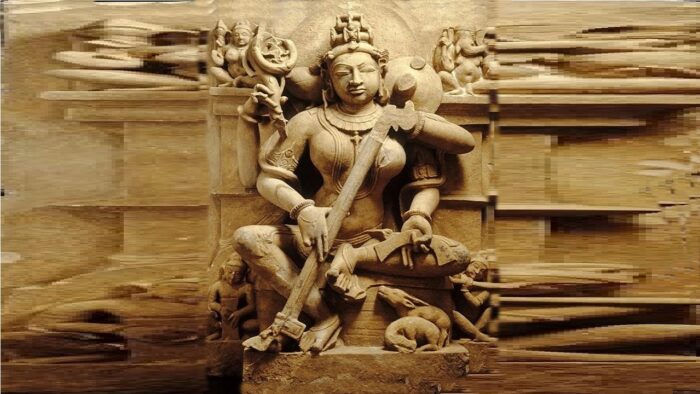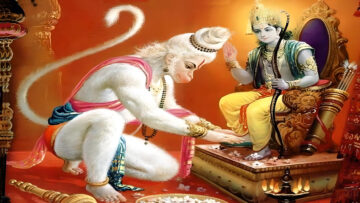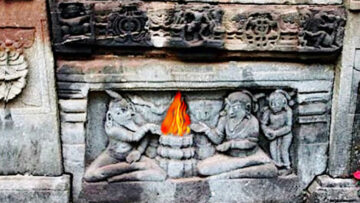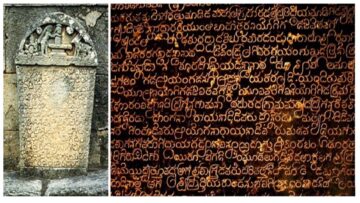Abstract
The concept of personifying knowledge as a goddess was the great vision and understanding of the sages of the Vedic period. In Indian art forms, she is depicted more like a beautiful goddess and an incarnation of knowledge. In this write-up, the right-hand and left-hand accessories held by Sarasvati are compared to the functions of the right and left lobes of the human brain structure, exploring the hidden physiological structure of the brain and the obvious iconographic representations.
Goddess Sarasvati is one of the first goddesses recorded in Hinduism,as the Goddess of infinite knowledge of both science and the arts. She is mentioned numerous times in the Rig Veda as the Goddess of jnana (knowledge) and Vak (speech), language, and learning. She is the “inciter of all pleasant music and inspirer of all gracious thought”. Sarasvati is also revered as the sacred river on the banks of which the Veda was inspired. She is called
“Ambitamenaditamedevitame Sarasvati” meaning
“the best mother, best of rivers, and the best of Goddesses”. (Rigveda 2.41.16)
(Figure 1: Sarasvati from Hoysala art)
Sarasvati is depicted in Indian temple sculptures and paintings in a personified form with multiple arms holding three accessories more frequently which are
- Books or palm leaf scriptures in her left hand, (indicative of the knowledge of secular science).
- A stringed musical instrument in her right hand (for she is the goddess of arts) and
- Rosary beads, Akshamala (indicative of spiritual yoga) in the top right hand.
Some sculptures also show her with a Pasha, Ankusha (as she guides in the path of knowledge), and palm leaves as accessories, all depending on her epithets.
The concept of personifying knowledge as a goddess was the great vision and understanding of the sages of the Vedic period. In Indian art forms, she is depicted more like a beautiful goddess and an incarnation of knowledge.
(Figure 2: Painting of Sarasvati from Mysore style)
The Goddess of cultured learning, science, and the art of music is expressed in Indian art by giving an iconographic representation of accessories. The human brain is structured mainly into two lobes, the right, and the left lobes. Depiction of Sarasvati is perhaps a figurative creation of the complex organ, the brain, and the capacities of the two lobes are represented as accessories in the hands of Sarasvati.
The right-hand and left-hand accessories are comparable to the functions of the right and left lobes of the human brain structure. The left and right sides of the brain operate at different capacities and are responsible for different functions in the body. The brain’s left half is primarily responsible for speech, abstract thinking, and science, indicated metaphorically as books in her left hand. The right side of the brain is responsible for image processing, and spatial thinking indicated by the stringed instrument for arts.
The two hemispheres of the brain communicate with each other through a bundle of nerves called the corpus callosum.The right and left lobes work better in coordination. This combined activity of coordination is expressed through the string instrument, Vina (also spelt Veena). The understanding here is that the multiple strings of the instrument Vina are again a metaphoric representation of the bundle of nerves of the corpus callosum. The instrument is always played using both the hands.
In the iconographic representation of Sarasvati in sculptures and paintings, she is depicted to be holding palm leaf scriptures or books always in her left hand. This, as an accessory held in the left hand, corresponds to the left lobe of the brain that helps in reading function. In the anthropomorphic depiction of Hindu deities, accessories held in their hands signify their capacities.A stringed instrument as another accessory is held or played on the right hand that corresponds to the right lobe of the brain which helps in learning arts.
About the two brain hemispheres
The theory based on the fact that the brain’s two hemispheres function differently came to light in 1981, thanks to the research of neuropsychologist and Nobel Prize winner, Roger W. Sperry. According to him,
- The left brain called the digital brain is more verbal, analytical, and orderly than the right brain. The left part of the brain is better at things like reading, language, writing, thinking in words, computation, logic, facts, sequencing, mathematics, etc.
- The right brain is called the analog brain, more visual and intuitive. It has a more creative and less organized way of thinking. It is better at things like arts, nonverbal cues, imagination, holistic thinking, feelings, visualization, rhythm, intuition, etc. Although the two sides function differently, they work together and complement each other. They do not operate singly. This is also depicted in Sarasvati as using both hands while playing the veena. The figure of Sarasvati can be analyzed for a pictorial expression of the theory of the functions of brain lobes.
The bridge between the two brain lobes
(Figure 3: Structure of corpus callosum in the physical brain and the instrument Vina, a comparison)
The corpus callosum is a large connecting part of the brain. It is made up of more than 200 million nerve fibers connecting the two cerebral hemispheres and shows slight thickening in the end. It is a thick tract of nerve fibers located at the base of the brain, connecting the left hemisphere of the brain like a connective pathway to the right hemisphere. It requires both sides of the brain to work together for a productive output. The corpus callosum measures around 10 centimeters (cm) in length and is like a bridge. It ensures that both sides of the brain have physical coordination and can communicate and send signals of complex information to each other. The corpus callosum shaped like the letter “C,” sits in the center of the brain running across the longitudinal fissure of the brain. (See figure 3).
In the iconography of Sarasvati as the Goddess of music, she holds the large stringed instrument, Vina. It has two lobes on both sides of the long central bridge that is in between. Several strings run on the bridge part and the coordinated action of plucking the strings on one end and pulling the strings on the bridge produces a pleasant sound vibration. The shape and significance of the Vina is a metaphor for the corpus callosum. They both work through the coordination of both hands, which correspond to the two hemispheres of the brain.
Figure 4: Painting of Sarasvati from Bali, Indonesia
The ancient sages of the Vedic period had a visualization of the brain structure and its functioning. They saw the powerful capacity of brain functions in the fields of learning science and the arts and created the figure of Sarasvati as the goddess of knowledge. Sarasvati has been given due importance in all temples and art representations of SE Asia and Japan. She is a revered goddess in these countries.
References
The left and right sides of the brain.
https://www.medicalnewstoday.com/articles/321037#left-vs-right
The Science Behind the Left and Right Brain, Written by Peter Hong
https://scc.sa.utoronto.ca/content/the-science-behind-the-left-and-right-brain/
Ralph T Griffith, Prof .J.L. Sastri (ed), The Hymns of the Ṛgveda, Motilal Banarsidass Publishers Private Limited, Delhi: 1973. 2004 Reprint, ISBN 81-208-0046-x (All quotes of Rig Veda referred to in this article in English are from this reference).
R.L Kashyap, “Rigveda Mantra Samhita”; Sakshi; Sri Aurobindo Kapali Sastry Institute of Vedic Culture, 2012
Picture courtesy:
- Walters Art Museum: Home page Info about artwork,Public Domain, https://commons.wikimedia.org/w/index.php?curid=27348921
- File: Halebid – Goddess Saraswati.jpg https://commons.wikimedia.org/wiki/File:Halebid_-_Goddess_Saraswati.jpg
- Personal collection, Rekha Rao. Painting from Ubud, Bali.
- Saraswati,#1, Mysore Painting, International Indian Folk Art Gallery. https://indianfolkart.org/product/saraswati-mysore-painting-30×24/.
Disclaimer: The opinions expressed in this article belong to the author. Indic Today is neither responsible nor liable for the accuracy, completeness, suitability, or validity of any information in the article.















